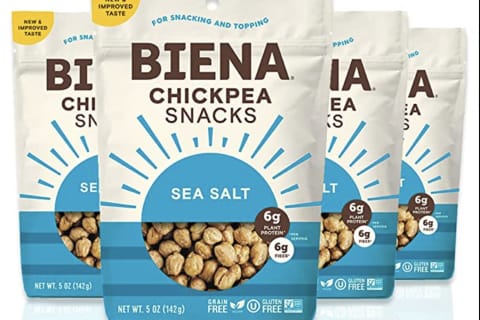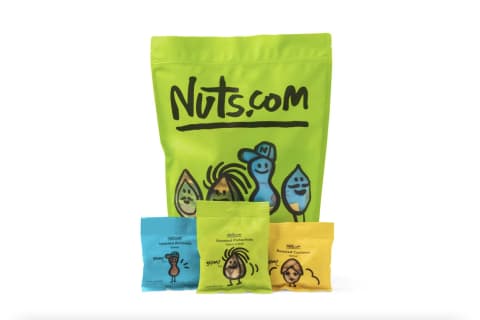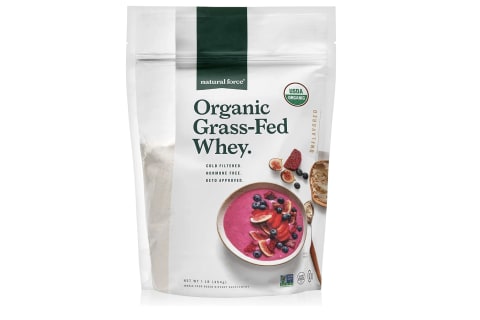19 Best High-Protein Snacks Of 2023 (Vegan, Keto & More)


Have you ever felt hungry right after a snack or felt that you needed to have multiple snacks per day in order to feel satisfied? If so, your snacks may need a protein upgrade.
Adding more protein to your meals and snacks is a smart way to maintain a healthy weight and support overall well-being.
Here are 19 delicious, nutritious, high-protein snacks to satisfy every craving. Whether you're looking for something homemade or store-bought, keto or vegan, we've got you covered.
Vegan high-protein snacks
For vegans, taking in enough protein can be challenging. However, if you know how to pair foods in the right way, it's easy to create high-protein, vegan-friendly snacks.
Here are a few high-protein snack options for people on a vegan diet:
Vegan protein smoothie
Ingredients: 1 scoop vegan protein powder, 1 cup frozen blueberries1, 1 tablespoon peanut butter2, and 1.5 cups unsweetened almond milk3
Protein per serving: 26.5 grams
Blend ingredients in a high-speed blender until smooth and creamy.
Trailmix
Ingredients: 1 ounce roasted almonds4, 1 tablespoon pumpkin seeds5, and ¼ cup raisins6
Protein per serving: 11.28 grams
Combine ingredients in a bowl and enjoy. Add some dairy-free dark chocolate chunks if you're in the mood for something sweet!
Peanut butter chia pudding
Ingredients: 2 tablespoons chia seeds7, 1 tablespoon peanut butter2, ½ cup oat milk8, and ½ cup fresh blackberries9
Protein per serving: 11.18 grams
Follow this recipe and add peanut butter to bump up the protein. You can sweeten your chia pudding with a zero-calorie sweetener like monk fruit or a drizzle of maple syrup if you'd like.
Salt and pepper oven-roasted edamame
Ingredients: 1 cup frozen prepared edamame beans10, salt, pepper
Protein per serving: 18.5 grams
Drizzle prepared edamame with olive oil and season with salt and pepper. Roast the edamame on a sheet pan at 375℉ for 20 to 30 minutes, stirring occasionally.
Vegetarian high-protein snacks
The following high-protein snacks are meat-free and vegetarian-friendly:
Greek yogurt parfait
Protein per serving: 17 grams
Top the Greek yogurt with the chopped apple and pecans, and sprinkle it with cinnamon to taste. Add a few tablespoons of low-sugar granola if you need some extra crunch.
Avocado egg salad
Ingredients: 2 hard-boiled eggs14 and ½ of an avocado15 served with crackers and sliced veggies
Protein per serving: 13.9 grams of protein plus a few grams of protein from the crackers and veggies.
Mash the eggs and avocado together and season with salt, pepper, and spices of your choice. Serve the egg salad with vegetables like sliced cucumbers and carrot slices or high-fiber crackers.
Apple, hemp seed, and sunflower seed butter sandwiches
Ingredients: 1 Honeycrisp apple16, 2 tablespoons peanut butter2, and 1 tablespoon hemp seeds17
Protein per serving: 10.75 grams
Make apple sandwiches by slicing apples into rounds, spreading them with peanut butter, making them into sandwiches, and rolling the sides in hemp seeds.
Meat high-protein snacks
If you eat meat, it's easy to put together high-protein snacks. It's always best to balance out meat-based snacks with some fruit or vegetables to make sure you're covering your nutritional needs for fiber, vitamins, minerals, and more.
Charcuterie sticks
Ingredient: 1 ounce Cheddar cheese18, 1 ounce salami19, and veggies of your choice like olives or roasted red peppers
Protein per serving: 14 grams
Layer your ingredients onto a skewer and enjoy.
Turkey, veggie, and cheese roll-ups
Ingredients: 4 slices of turkey breast20, 2 slices Swiss cheese21, romaine, sliced tomatoes, and mustard.
Protein per serving: 19.488 grams
Layer the turkey slices with the rest of the ingredients, roll them up, and enjoy.
Small salad with chicken
Ingredients: 2 ounces of chicken breast22, sliced avocado, cherry tomatoes, and 1 tablespoon pumpkin seeds5.
Protein per serving: 20.96 grams
Add chopped greens of your choice to a bowl and top with chicken, tomatoes, sliced avocados, and pumpkin seeds. Make your own Greek-yogurt-based dressing to increase the protein content even more.
Keto high-protein snacks
When you're following a low-carb diet, protein is usually in high demand. Protein-rich snacks can help keep your blood sugar stable and keep you feeling full and satisfied between meals.
People on low-carb diets should prioritize pairing foods high in protein with high-fiber ingredients to support digestive health.
Here are a few options for low-carb, high-protein snacks.
Tuna salad
Ingredients: 1 can of tuna23, 1 tablespoon of mayo24, 2 tablespoons Greek yogurt24, chopped celery and red onion, served on top of cucumber slices
Protein per serving: 42.8 grams
Mix the tuna with the mayo and Greek yogurt and enjoy.
Masala Egg Bites
Ingredients: 4 eggs, ½ cup full-fat cottage cheese, ½ cup shredded Cheddar cheese, onion, bell pepper, chile
Protein per serving: 12.43 grams per bite
Peanut butter chocolate protein balls
Ingredients: 1 cup peanut butter2, 3 scoops mindbodygreen chocolate beauty & gut collagen+, and monk fruit and vanilla extract to taste.
Protein per serving: 15 grams per 2 balls
Combine all of the ingredients in a food processor and blend until incorporated. Chill for 20 minutes before rolling into balls. Roll in crushed peanuts for extra crunch and even more protein. Store them in the refrigerator.
Packaged high-protein snacks
Sometimes, you need a protein-rich snack that's premade. In order for a packaged food to carry a "high protein" label, it must contain 20% or more of the dietary reference value (DRV) for protein per serving, which is set at 50 grams25 for a 2,000-calorie diet.
Keep these high-protein snacks in your car, desk, or work fridge so you're always prepared with a filling snack when hunger hits.
High-protein snacks to buy
Turkey sticks
Protein per serving: 10 grams per stick
Look for turkey sticks that don't contain added sugar and are made with humanely raised turkey. Pair turkey sticks with a piece of fresh fruit for a protein- and fiber-rich snack.
Protein bars
Protein per serving: 10 to 15 grams per bar
Choose protein bars that provide at least 10 grams per bar and are made with whole, nutrient-dense ingredients, like nuts and fruit. Steer clear of bars that contain more than 4 grams of added sugar.
Mixed nuts
Protein per serving:~10 grams per 2-ounce serving
Peanuts, almonds, cashews, pistachios, and seeds like pumpkin seeds can be mixed together to make a travel-friendly snack.
Roasted chickpeas
Protein per serving: ~12 grams per 2-ounce serving
Look for roasted chickpea products that are made with healthy oils, like avocado oil.
Cottage cheese
Protein per serving: ~12 grams per 4-ounce serving
Cottage cheese is a high-protein snack that can be enjoyed with sweet ingredients like berries and nut butter, or savory ingredients like vegetables and avocado. Don't be afraid to experiment with different flavor combinations!
Protein powder
Protein per serving: ~20 grams per scoop
Protein powder is a convenient high-protein ingredient to keep on hand. You can add it to water or your milk of choice to make a protein shake on the road and can add it to low-protein foods, like plant-based yogurt, in order to give your snack some staying power.
What is protein and why is it important?
Protein is a macronutrient, which is a nutrient that your body needs in large amounts. Protein is known for its role in muscle protein synthesis and maintenance, but it's also necessary for hormone and neurotransmitter production, immune function, and many other essential processes.
Taking in optimal protein on a daily basis helps keep your body healthy and is important for maintaining lean muscle mass and bone strength. Following a higher-protein diet is also effective for promoting weight loss26 and can make it easier to reach your body composition goals.
Fortunately, there are plenty of sources of protein to choose from, no matter what type of diet you choose to follow. Eating a combination of plant- and animal-based proteins is the best way to cover your daily protein needs, but some people follow diets that restrict or cut out animal-based products.
Even though it's entirely possible to meet your protein needs following a plant-based diet, animal-based proteins are considered27 to be of higher nutritional quality compared to plant-based protein.
This is because plant-based proteins lack some essential amino acids, like lysine, and have lower digestibility compared with animal proteins.
"Two scoring systems—the protein-digestibility corrected amino acid score (PDCAAS) and the digestible indispensable amino score (DIAAS)—would say that animal-source proteins have higher scores. In other words, they are more digestible and have a higher content of essential (indispensable) amino acids, the amino acids we need to get from our food" Stuart Phillips, Ph.D., a protein researcher and professor at McMaster University, tells mindbodygreen.
So, if you're following a strict plant-based diet, you'll need to pay extra attention to your protein choices to make sure you're getting enough of this essential macronutrient on a daily basis. Phillips encourages those following a plant-based diet to think about adding protein to every meal and snack to ensure they're taking in a variety of amino acids and hitting their protein goals.
Summary
How much protein do I need?
Even though the current recommended dietary allowance (RDA)28 for protein is set at 0.8 gram per kg (g/kg) of body weight [0.36 gram of protein per pound (g/lb)], research suggests that the optimal protein intake28 for active people is closer to 1.2 to 2.0 g/kg per day (0.54 to 0.9 g/lb). For a 150-pound person, this would equate to 81 to 135 grams of protein per day.
This is because the RDA is the minimum amount of protein your body needs to meet amino acid requirements, prevent muscle loss, and maintain nitrogen balance, not the optimal amount of protein needed to support overall health.
In order to meet your protein needs, it's important to add sources of protein to every meal and snack.
Most experts suggest taking in 25 to 30 grams29 of protein at meals, but what about snacks? Say you're a 150-pound person aiming for a protein intake of 0.8 gram per pound per day or 120 grams of protein per day. If you take in 100 grams of protein over three meals, that means you'll need to fit in a snack that contains 20 grams of protein to fulfill your protein requirements.
If you're not paying that much attention to your macro intake and just want to make sure you're eating enough protein, choosing snacks that contain at least 10 grams of protein is usually enough to help keep you satisfied until your next meal.
For people looking to make the most out of their workouts, like athletes, study findings suggest that, as long as you're consuming protein around your workout, it doesn't matter if you prefer to have a high-protein snack or protein shake before or after training. Experts agree that focusing on consuming enough total protein throughout your day is much more important for muscle building and strength than pre- or post-workout protein supplementation.
Summary
Can high-protein snacks help me lose weight?
Upping your protein intake can be an effective way to lose body fat, as long as you're following an overall healthy diet, doing resistance training, and maintaining a calorie deficit.
Because protein is the most filling macronutrient and is important for muscle maintenance, following a high-protein diet can reduce hunger levels and help you maintain your muscle mass during weight loss. Usually, your basal metabolic rate (BMR) or the calories you burn while you're at rest, drops when you lose weight. However, studies show26 that high-protein diets help people losing weight maintain their BMR over time, which can help them sustain their weight loss.
A 2020 review26 published in the Journal of Obesity and Metabolic Syndrome reported that not only have high-protein diets been shown to be effective for promoting fat loss, but they also seem to be helpful for preventing weight regain over time.
Summary
Frequently asked questions
What snack is highest in protein?
Animal proteins like chicken, turkey, and tuna fish are a concentrated source of protein. For example, one can of tuna provides over 40 grams of protein. In terms of plant-based options, edamame and legume-based snacks like roasted chickpeas are the highest in protein. Protein powders, including plant and animal-based products, can also be used to pack protein into snacks.
How can I get 20 grams of protein in a snack?
You can create a high-protein snack by using ingredients like cottage cheese, protein powder, tuna, chicken, edamame or chickpeas, and peanut butter. For example, you can easily exceed 20 grams of protein by making a simple protein shake with a scoop of protein powder, a tablespoon of peanut butter, frozen berries, and your milk of choice. Another way to boost the protein content of a snack? Put an egg on it. "I'll top just about anything with a sunny-side-up egg," Maggie Moon, M.S., R.D., previously told mindbodygreen. Try topping snacks like avocado toast with an egg or adding hardboiled eggs to snack boards for a protein boost.
The takeaway
If you're looking for a way to stay satiated throughout your day, adding a protein-rich snack or two could help. And no matter if you're following a vegan diet or have recently transitioned to a low-carb way of eating, there are plenty of tasty high-protein snacks to choose from.

Jillian Kubala, MS, RD is a Registered Dietitian based in Westhampton, NY. She holds a master's degree in nutrition from Stony Brook University School of Medicine as well as an undergraduate degree in nutrition science.
In addition to her private practice where she uses a unique and personalized approach to help her clients achieve optimal wellness, she works as a freelance writer and editor and has written hundreds of articles on nutrition and wellness for top digital health publishers.
Jillian and her husband have a backyard farm where they grow their own food and keep chickens. She runs a small cut flower business specializing in organically grown dahlias.
29 Sources
- https://fdc.nal.usda.gov/fdc-app.html#/food-details/173950/nutrients
- https://fdc.nal.usda.gov/fdc-app.html#/food-details/172470/nutrients
- https://fdc.nal.usda.gov/fdc-app.html#/food-details/174832/nutrients
- https://fdc.nal.usda.gov/fdc-app.html#/food-details/170567/nutrients
- https://fdc.nal.usda.gov/fdc-app.html#/food-details/170556/nutrients
- https://fdc.nal.usda.gov/fdc-app.html#/food-details/2407517/nutrients
- https://fdc.nal.usda.gov/fdc-app.html#/food-details/170554/nutrients
- https://fdc.nal.usda.gov/fdc-app.html#/food-details/2392509/nutrients
- https://fdc.nal.usda.gov/fdc-app.html#/food-details/173946/nutrients
- https://fdc.nal.usda.gov/fdc-app.html#/food-details/168411/nutrients
- https://fdc.nal.usda.gov/fdc-app.html#/food-details/2466709/nutrients
- https://fdc.nal.usda.gov/fdc-app.html#/food-details/168203/nutrients
- https://fdc.nal.usda.gov/fdc-app.html#/food-details/2025217/nutrients
- https://fdc.nal.usda.gov/fdc-app.html#/food-details/173424/nutrients
- https://fdc.nal.usda.gov/fdc-app.html#/food-details/171706/nutrients
- https://fdc.nal.usda.gov/fdc-app.html#/food-details/2379213/nutrients
- https://fdc.nal.usda.gov/fdc-app.html#/food-details/170148/nutrients
- https://fdc.nal.usda.gov/fdc-app.html#/food-details/2057648/nutrients
- https://fdc.nal.usda.gov/fdc-app.html#/food-details/2418445/nutrients
- https://fdc.nal.usda.gov/fdc-app.html#/food-details/172941/nutrients
- https://fdc.nal.usda.gov/fdc-app.html#/food-details/2409699/nutrients
- https://fdc.nal.usda.gov/fdc-app.html#/food-details/171075/nutrients
- https://fdc.nal.usda.gov/fdc-app.html#/food-details/175158/nutrients
- https://fdc.nal.usda.gov/fdc-app.html#/food-details/2368950/nutrients
- https://www.fda.gov/food/new-nutrition-facts-label/daily-value-new-nutrition-and-supplement-facts-labels
- https://www.ncbi.nlm.nih.gov/pmc/articles/PMC7539343/
- https://www.sciencedirect.com/science/article/abs/pii/S0924224421006774
- https://www.ncbi.nlm.nih.gov/pmc/articles/PMC6566799/
- https://www.ncbi.nlm.nih.gov/pmc/articles/PMC5872778




